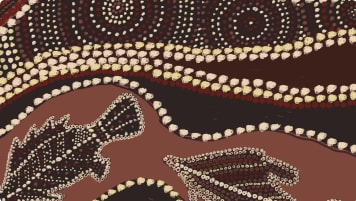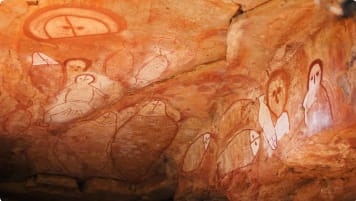Warri and Yatungka: Last of the Gibson Desert Nomads
Peasley recounts the outback Australia in Western Australia to find Warri and Yatungka in the Gibson desert. A touching story and introduction to totems and songlines of first nation peoples. An Antipodean travel company serving World Travellers since 1983 with small group educational tours for senior couples and mature solo travellers.
4 Feb 22 · 11 mins read

The Story of Warri and Yatungka
By Marco Stojanovik
Warri and Yatungka were the last of the Mandildjara nomadic people to remain in their country – the Western Gibson Desert region of Western Australia. Having fall in love in the 1930s, they chose to elope as Indigenous tribal law forbade their relationship. Gradually as the rest of their people moved to urban settlements, this couple continued to live nomadically in the desert. They survived isolated for about 40 years, walking from water hole to water hole, hunting, and eating native fruits.
But when a severe drought – the worst of the century – struck the region in 1977, the Mandildjara feared Warri and Yatungka would not be able to hold out. Without the support of younger tribesmen and women, their chances of survival under such adverse conditions were extremely low. So, a local indigenous elder Mudjon, the Australian explorer Stan Gratte, and a small party set out to find the elderly couple believed to be the last living a traditional Indigenous nomadic existence.
This extraordinary journey was recorded by a member of the party, W J Peasley, in his book The Last of the Nomads. That information has been used to create this article, summarising the Story of Warri and Yatungka, intended as background reading for Odyssey Traveller’s Central and Western Australia Aboriginal Art Tour for senior couples and solo travellers. With Odyssey Traveller you can explore the landscapes of Outback Australia country, inspiration for Aboriginal art and design.

The Indigenous People of the Gibson Desert
Warri and Yatungka were members of the Mandildjara tribe of the Gibson Desert of Western Australia. The Gibson is located between the Rawlinson Ranges in the east and Lake Disappointment hundreds of kilometres away to the west. In the north it merges with the Great Sandy Desert and, in the south, with the Great Victoria Desert. It contains expansive areas of undulating red sand plains and dune fields, gravel-covered terrains, spinifex plains, and belts of mulga trees.
The Mandildjara, along with the Budidjara, the Gadudjara, the Ngadjara, the Wanman, and many other tribes once populated the Gibson in large numbers. It was their country, their home. Peasley writes, “They were as one with the rocks, the dry creeks, the rock holes that were created long ago by Wati Kudjara, the two mythical men whose work could be seen at every turn.”

Isolated in the desert, these peoples had little contact with the outside world prior to the early 1880s. So, they were free to maintain their traditional way of life. They were more fortunate than other Aboriginal groups across the Australian continent. They were deeply spiritually bonded to their country, the land regarded as the essence of their being, and so many Aboriginal groups could not retreat before the advancing settlements of the Europeans.
Lacking the numbers and organisation to resist the invaders, within a few short years the tribes that occupied the coastal regions of Australia largely disappeared. Peasley writes, “The sacred sites were despoiled by the colonists, their land was taken from them, they were prevented from hunting over territory that had been theirs since the Dreamtime, and they were punished for infringements of the white man’s laws, laws that they could not comprehend.”
Then by the early years of the 20th century, the white man’s presence also began to be felt in the Gibson Desert. With the establishment of a series of permanent wells across the desert from Wiluna to Halls Creek – a distance of 1,600 km – it was now possible for cattle to travel from the Kimberley to the railhead at Wiluna across formerly waterless country.
This was to have a significant impact on the desert people. Making use of the sure water supply from the white man’s wells, they soon began to interact with the drovers pushing their herds across the desolate land. With this, their isolation began to break down and movement out of the desert began. Before long the movement rapidly gained momentum, with few Aboriginal people returning to their tribal lands once they left.
In the 1950s and 60s, government policy encouraged those who remained in the desert to settle in mission stations and reserves on the fringes of settlements to be ‘civilised’. Others came without any encouragement, drifting into the settled areas in a pattern that had been occurring around Australia for more than 150 years.

Much of the older generation did not display the same curiosity in the white man’s ways as the younger members of the tribes and remained on their land. They experienced a great burden though without sufficient numbers of young men and women to support them.
By the mid-1970s, the movement was almost complete, with the country of the Gibson Desert tribes virtually empty. However, two people of the Mandildjara – Warri and Yatungka –remained to hunt and gather food across their country as their ancestors had done before them. At that time, they were believed to be the very last of the Aboriginal nomads surviving in the desert.
Warri and Yatungka Remain in the Desert
Warri and Yatungka chose to remain in their ancestral land when their kinsfolk moved out to missions and settlements for two reasons. For one, they held a deep love for their own land, their country. They were bounded to the soil as an essential part of their existence, something they could never give up.
But they also feared the retribution that would be sought by the Mandildjara elders should they re-join their tribe. In the 1930s, the couple had breached tribal law which prohibited their relationship as they were not of the same skin group. Instead of pursuing marriages in accordance with the law and approval of the elders, the two lovers ran off together in the middle of the night, receiving sanctuary in the neighbouring lands of the Budijara people. If they were to return to their homelands, punishment for their actions could have been in the form of physical injury or even death.
The Mandildjara elders attempted to track down the couple and convince them to return, but they were unsuccessful. And so, Warri and Yatungka remained isolated, living in exile for a great many years.
This was an unhappy time for the couple living outside their own country. Peasley writes, “No Mandildjara man or woman could be happy if they were unable to wander the land of their birth, to hunt and gather food and to participate in the social gatherings and scared rituals of their people. They were exiles, living in a strange land, amongst strange people.” Eventually, unable to bear the longing sadness for their own country, they chose to return and face the consequences of their actions.
Back in the land of the Mandildjara, however, they found that much had changed during their absence. Most of their people had since left the desert, with only remnants of the tribe still wandering their country in small family groups. There was little social organisation and no body of elders to ensure that the law was upheld, and so Warri and Yatungka were not punished for their defiance of the marriage rules. The couple, with their children they had since borne, became just another family unit moving up an down their ancestral land.
Then over the following years, more and more of their remaining kinsfolk left their country for the attractions of the white man’s world. Their own children too were forced to leave as they came adults, travelling south for initiation and to seek wives. Here they chose to remain, occasionally returning to their homelands for brief visits.
The time came when Warri and Yatungka were the only human occupants of the Mandildjara land. Alone they wandered as their ancestors had done for centuries, moving from one water hole to another, hunting and food gathering.
Gibson Desert Drought
When the rains fell and seasons were good, there was an abundance of water in the soaks and rock holes, game was plentiful, and life was not too difficult for Warri and Yatungka. But by 1977, little rain had fallen for three years, and a great draught descended upon their land. The water holes gradually dried up and animal and birdlife perished or moved away to more hospitable regions.
In the past, the young men and women of the Mandildjara would travel great distances for the daily search for food in these circumstances. In doing so, they could obtain sufficient food to support the old. Without the young, however, life for Warri and Yatungka became extremely difficult during this time.
The Mandildjara elders grew increasingly concerned for their safety. Despite Warri and Yatungka’s transgressions, the Mandildjara elders never forgot about them and constantly worried about their welfare. When, in the late winter of 1976, an expedition into the Gibson Desert sighted smoke on the horizon, the elders concluded that it could only have come from a fire made by Warri and Yatungka. They were still alive.
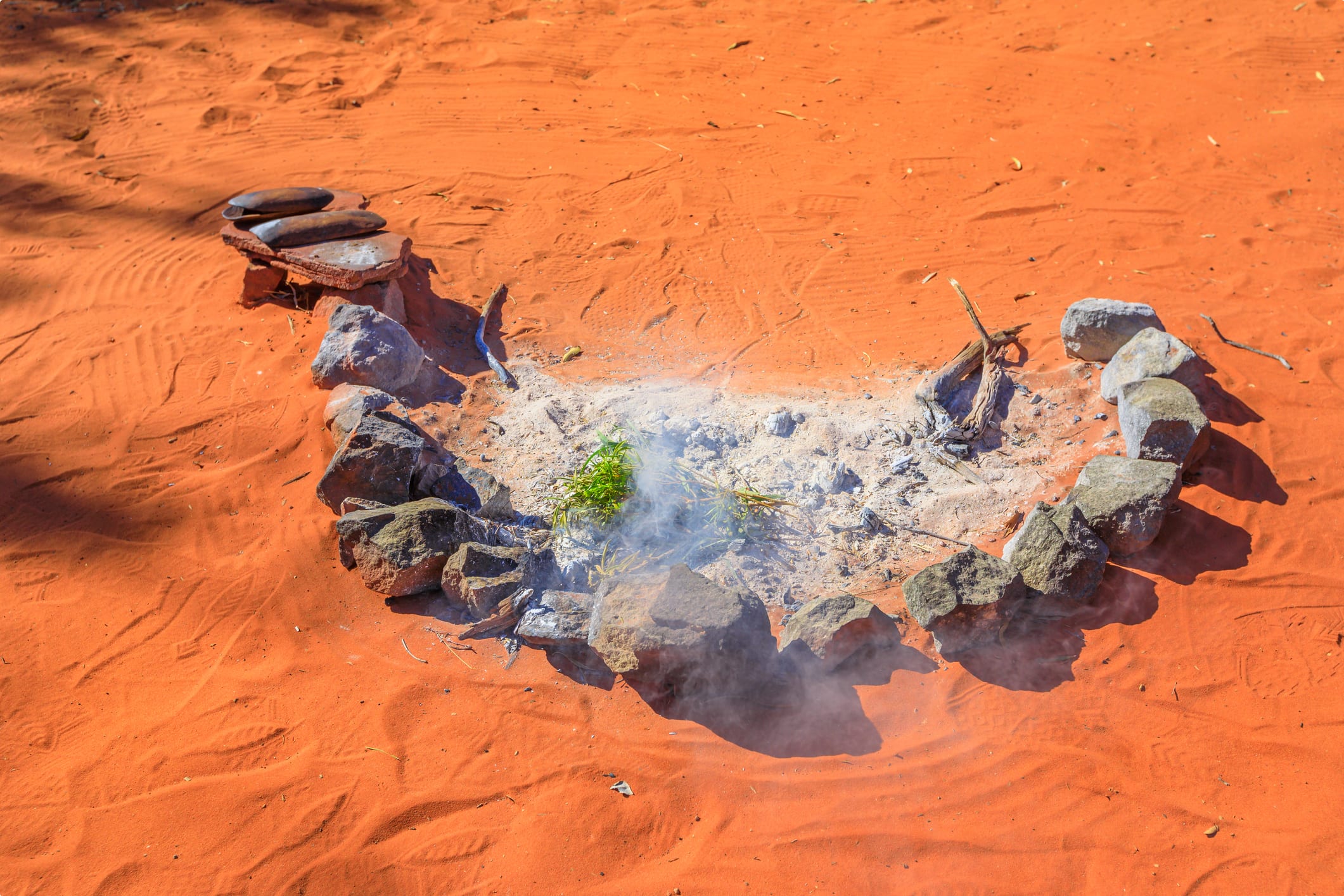
As the draught worsened over 1977, one of the elders named Mudjon convinced the explorer Stan Gratte to mount an expedition into the Gibson to search for the couple. Conditions were becoming more and more harsh in the desert and with Warri in his 70s and Yatunga in her late 50s or early 60s, it would harder and harder in their old age to survive. It was imperative they be found in the next few weeks.
Finding Warri and Yatungka
In August 1977 a small search party assembled in the little town of Wiluna – home to many former Aboriginal desert dwellers. The party consisted of five white men: Mr Stan Gratte, Mr William John Weasley, Dr John Hanrahan, Mr Harry Lever, and Mr Mark Whittome; and one Aboriginal, Mudjon.
Travelling with three four-wheeled drive vehicles – a Toyota Land Cruiser, a Range Rover, and a Land Rover – they combed the remote Gibson Desert for weeks looking for Warri and Yatungka. Trekking from one water hole to the next, they sent off smoke signals hoping to receive some sort of response in return from the couple.
But, finding only dry water holes, the likelihood of receiving a response became more and more dim as the weeks went on. Finally, the rescue party decided to head for a place known as Ngarinarri – a water hole where during severe draught the Mandidjara used to gather, able to survive until the rains came. Ngarinarri was known to always contain water, even during the longest drought. It would be the last possible source of water in the desert, the last resort for Warri and Yatungka.
Approaching Ngarinarri, Mudjon suddenly shouted and pointed excitedly towards the north. A faint wisp of smoke was spiralling into the blue grey sky of the late hour of the day. Somebody was alive out there.
Rising early the next morning, the rescue party headed in the direction of the smoke, until they sighted a sole figure moving slowly east lighting patches of spinifex. Unable to contain himself, a highly excited Mudjon plunged down the down the face of a sand ridge, striding briskly out to intercept the figure.
There he confirmed that the figure was indeed Warri, although in a weak and emaciated state. Scratches and scars covered his trunk, his right eyelid drooped slightly, and he appeared to be suffering from trachoma (which being in an advanced stage would have greatly reduced his vision). Meanwhile his arm showed considerable wasting and his right leg was wrapped in a piece of cloth covering an infected lesion which appeared to cause considerable pain.
Still there was no sign of Yatungka, but Warri explained that she was indeed alive and at that moment gathering fruit out east from quandong trees, which had been their main food in recent weeks.
Warri led the party to his camp on the claypan which contained the well, Ngarinarri. Here, he and Yatungka had been living day to day collecting enough water from the well and gathering whatever food that could be procured each day to keep them alive.
When Yatungka later returned to camp, she seemed in a much better condition than Warri, although still quite emaciated. As Warri had been sick and injured, it was Yatungka who had been able to obtain sufficient water and walk the long distances to collect food to sustain the two of them in the past weeks. Peasley writes, “Without Yatungka’s devotion, Warri must surely have perished long before our encounter with them. He was utterly dependent upon her for survival.”
Leaving the Desert
Upon finding Warri and Yatungka, Mudjon, as an elder of the Mandildjara with great authority, assured them that their past transgressions would be forgiven and they would not be punished. So, the couple agreed to leave Ngarinarri and accompany the party on their long journey south back to Wiluna.
Peasley writes, “They had reached the end of the road, they were weak and there was nowhere for them to go from Ngarinarri. They could no longer live in their own country without the help and support of the young people and there were none left in the land of the Mandildjara.”
As Mudjon promised, there was no hostility toward the couple upon reaching Wiluna. Peasley describes instead “a moving scene” in which “one sensed the tremendous feeling of relief amongst the people that the old couple had survived, but it was tinged with sadness as they noted the frail bodies and realised that Warri and Yatungka were in a precarious state of health.”
In the weeks that followed their arrival, Warri and Yatungka were sent to the hospital at Meekatharra, where with good food and medical treatment they made an excellent recovery and were once more able to join their people at Wiluna.
In the following months Warri and Yatunga seemed to be reasonably happy, never openly expressing any desire to return to Ngarinarri. Warri rarely spoke, content to sit for long periods of time before his fire. Yatungka, meanwhile, as she overcame her shyness and her fear or tribal retribution, took more active part in the affairs of the people. All the while, as Peasley writes, “they remained as inseparable as they had been during the long years in the desert, reluctant to let each other out of sight”.
They remained in Wiluna until 1979, when Warri became ill and despite treatment died on the 28th of April. Yatungka, who had developed the same illness, was profoundly depressed by her husband’s death. Unable to imagine life without him, she refused to take food and drink and soon joined him, passing away on 23rd of May 1979, less than four weeks after his death.
At the time, the couple were thought to be the last of Australian Aboriginal desert nomads. In fact, though, several more nomadic Aboriginal people came in from the desert in subsequent years. The final group was the Pintupi Nine, who first contacted the western world in 1984. No story was quite as romantic, however, as that of the Mandildjara couple.
Tour of Aboriginal Western Australia
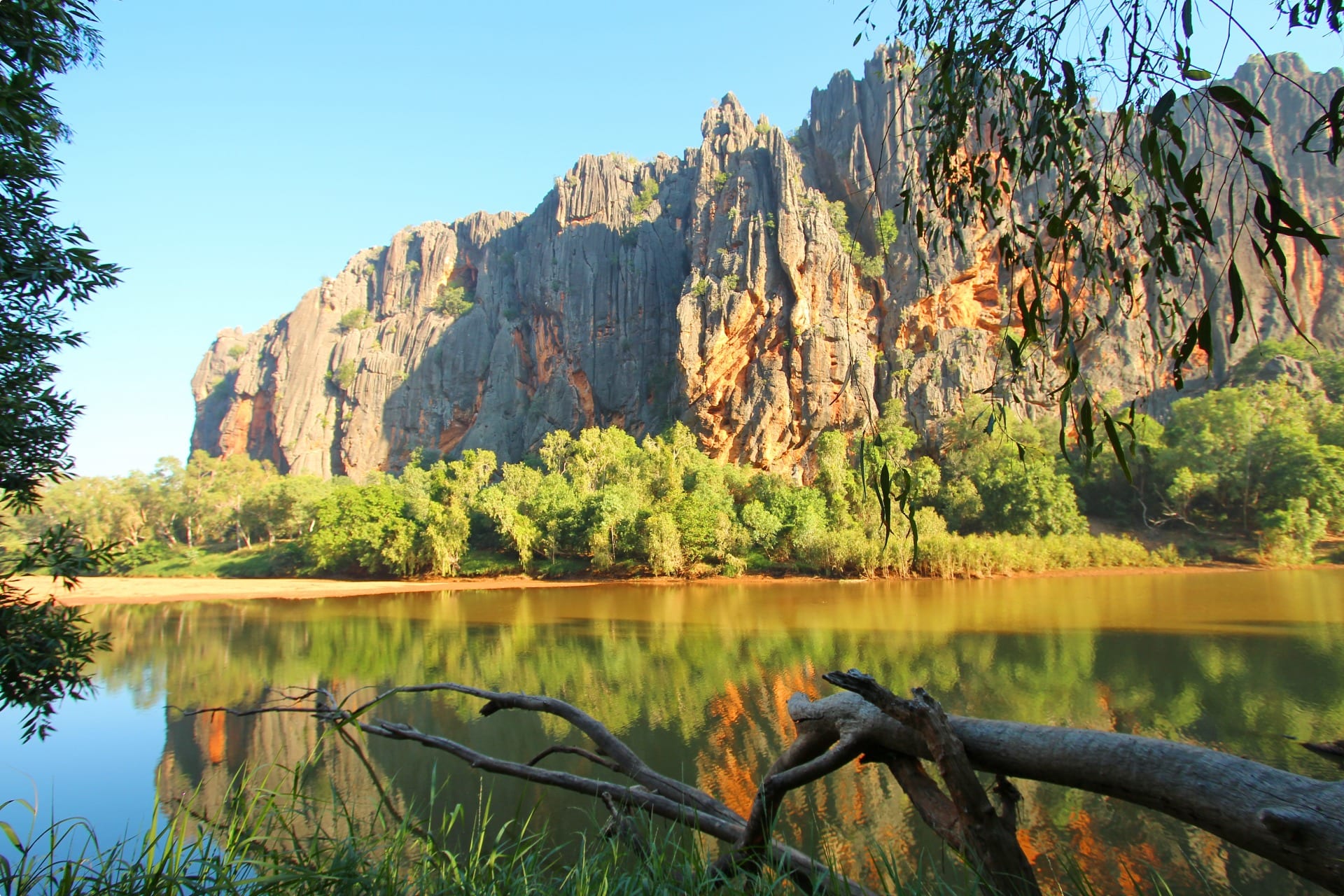
Odyssey Traveller visits the landscapes of Aboriginal country in our Central and Western Australia Aboriginal Art Tour. Limited to eight people, this small group tour is for 13 days by air into some of the most remote areas of the outback. It is an adventure tour for travellers, whether a couple or solo traveller, who are seeking a guided tour into the outback to study and learn about Aboriginal art.
Starting and ending in Alice Springs, the itinerary is designed to optimise your time in outback Australia from the air and the ground, with some great guided tour leaders showing you the country across Western Australia and the Northern Territory. Blending a deep history and contemporary Aboriginal art, the tour promises to shape your interpretation of outback Australia.
Our other tours to outback Western Australia with a focus on historic and contemporary Aboriginal Australia include:
- Small Group Tour of Australia’s Kimberly
- Kimberley, Purnululu, Tiwi Islands and Arnhem Land
- Broome – Darwin Small Group Tour
- Kimberley and Pilbara Explored by Air
- Central and Western Australia by Air
Odyssey Traveller has been serving global travellers since 1983 with educational tours of the history, culture, and architecture of our destinations designed for mature and senior travellers. We specialise in offering small group tours partnering with a local tour guide at each destination to provide a relaxed and comfortable pace and atmosphere that sets us apart from larger tour groups. Tours consist of small groups of between 6 and 12 people and are cost inclusive of all entrances, tipping and majority of meals. For more information, click here, and head to this page to make a booking.
Articles about Australia published by Odyssey Traveller:
- The Kimberley: A Definitive Guide
- Uncovering the Ancient History of Aboriginal Australia
- Aboriginal Land Use in the Mallee
- Understanding Aboriginal Aquaculture
- Mallee and Mulga: Two Iconic and Typically Inland Australian Plant Communities (By Dr. Sandy Scott).
- The Australian Outback: A Definitive Guide
For all the articles Odyssey Traveller has published for mature aged and senior travellers, click through on this link.
External articles to assist you on your visit to Western Australia:
Related Tours
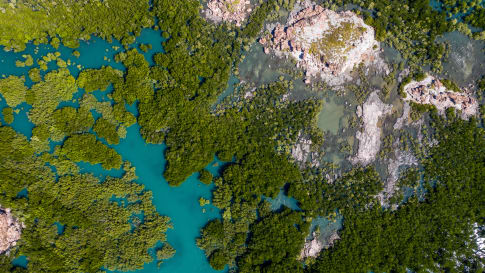
days
MarCentral and Western Australia Aboriginal art tour
Visiting Northern Territory, Western Australia
Small group escorted air tour of Central and Western Australia, where the coaches have yet to reach. Outback Australia, Aboriginal art, Standing stones, Derby, Broome, Tanami desert, Kununurra explored for mature couples and single travelers.
Led by Adrian Newstead explore Outback Australia, and inspiration for Aboriginal art and design through the landscapes of country. Limited places for senior couples and solo travellers. Two departures a year.

days
Apr, May, Jul, Aug, Sep +2Central and Western Australia by Air
Visiting Northern Territory, Western Australia
Small group escorted air tour of Central and Western Australia, where the coaches have yet to reach. Outback Australia, Aboriginal art, Standing stones, Derby, Broome, Tanami desert, Kununurra explored for mature couples and single travelers.

14 days
Apr, Jul, SepKimberley and Pilbara explored by air
Visiting Northern Territory, Victoria
Small group air charter tour of the Kimberley and Pilbara for senior and mature couples and single travellers. Learn about Purnululu, Bradshaw art, visit Derby, Broome and Alice Springs.
From A$24,695 AUD
View Tour
days
Mar, AprBroome - Darwin small group tour
Visiting Northern Territory, Western Australia
For senior couples and solo travellers interested in small group tours of learning about Aboriginal Australia and the outback in Australia. This educational tour visits the Kimberley, Derby, Katherine, Kakadu, Darwin and the Tiwi islands. Plenty of Aboriginal history with the colonial overlay to experience first hand.
From A$18,995 AUD
View Tour
13 days
May, Jun, Jul, Aug, SepSmall group tour of Australia's Kimberley
Visiting Western Australia
Escorted small group tour of the Kimberley. We explore and visit The Bungles, Bell Gorge, Mitchell plateau & Halls Creek in the dry season. Amazing landscapes intertwined with Aboriginal communities resident more than 45,000 years.
From A$15,390 AUD
View Tour
22 days
Feb, Mar, Apr, Jun, Aug +1Western Australia tour
Visiting Western Australia
Escorted small group tour for senior and mature travellers as a couple of solo traveller. Upto 12 people of WA's regional History tour. The program including Esperance, Kalgoorlie, Gwalia and Perth. Local guides and program leader share knowledge about this fascinating region.
From A$13,695 AUD
View Tour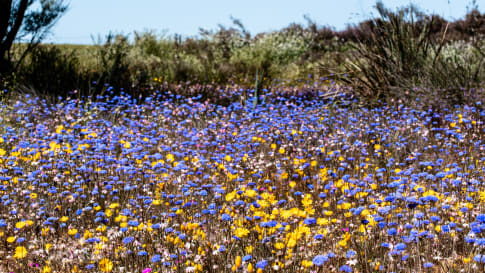
15 days
Aug, SepWildflowers tour of Western Australia
Visiting Western Australia
Escorted small group tour for senior and mature travellers as a couple of solo traveller. Upto 12 people of WA's Wildflower regions including Esperance and the Fitzgerald river National park. Local guides and program leader share knowledge about this fascinating region whilst in bloom.
From A$12,250 AUD
View TourRelated Articles
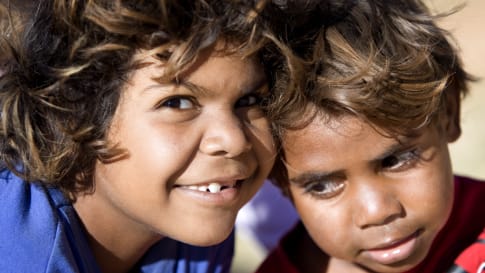
Aboriginal Kinship systems
Article about Aboriginal kinship to assist small group tours in Australia understanding Ancient aboriginal society and the contemporary view. Kinship influences the relationships including aboriginal trading routes.
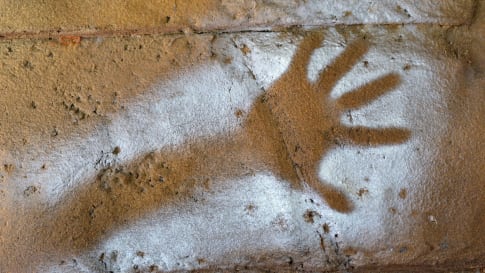
Aboriginal Messages
An Antipodean travel company serving World Travellers since 1983 with small group educational tours for senior couples and mature solo travellers. Article part of series about Australia and its first nation people who have settled here for some 120,000 years.

Aboriginal Songlines
Songlines trace the journeys of ancestral spirits who created the land and all natural phenomena. The creation stories as well as practical knowledge needed for survival in outback Australia. We experience this knowledge on our small group tours into Outback Australia.

Ancient Aboriginal trade routes of Australia
Ancient Aboriginal trade routes of Australia Trade was a central part of life for Aboriginal people prior to the British settlement of Australia. Trading routes criss-crossed the nation, dispersing goods, information, technologies and culture thousands…

Australian Aboriginal Paths of Migration
Article for small group tours of mature or senior couples or solo travellers interested in learning more about Aboriginal history, Kinship, trading routes, songlines and ancient history.
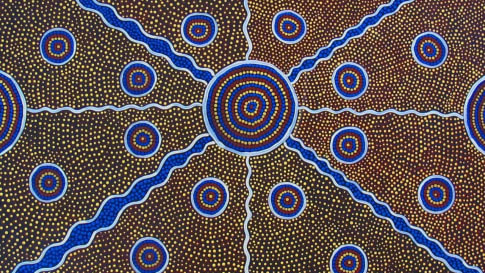
Historical Aboriginal Marketplaces
Article about Aboriginal history and trading routes and marketplaces in outback Australia. Supporting small group tours for senior and mature couples and solo travellers.
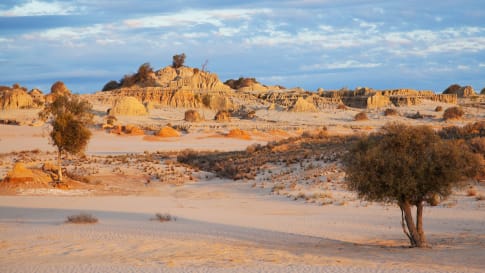
Mungo Man and Mungo Lady, New South Wales
Part of a small group tour of World heritage sites on Victoria, NSW & South Australia for mature and senior travellers. Learn and explore in the Mungo National park about Aboriginal settlement and the fauna and flora of this National park.

Uncovering the ancient history of Aboriginal Australia
For small group escorted tours of Australia in Queensland, Victoria, New South Wales, South Australia, Tasmania, Western Australia and the Northern Territory a guide on Aboriginal culture for mature and senior travellers.
